DevSkiller Digital & IT Skills Report 2023
Foreword
Technology changes fast, and the demand for skilled talent has increased with it, even as the economy slows down. In 2022, despite hiring freezes, economic uncertainty, and geopolitical conflicts, the need for advancement continues to move forward.
At DevSkiller, we provide a cloud platform for skill-based companies to discover, measure and grow talent. This year, we’ve renamed the DevSkiller IT Skills Report to incorporate digital skills, as digital technology is evolving rapidly.
We hope to provide the community with valuable data to give insight on how to assess and manage skills. We look at candidates, not only as pre-qualified job-seekers but also as someone who desires to change their role within the same company.
We are witnessing a historic level of talent shortage as the world slowly recovers from the COVID-19 pandemic. The demand for skilled roles continues to rapidly increase while workforce participation stagnates.
In this report, we lay out some of the emerging trends of the past year and lay out our predictions for the year to come from the data we have gathered across the DevSkiller platform.
Best wishes for the year ahead
Jakub Kubrynski
DevSkiller CEO & Cofounder
Table of contents
Want a copy to take home?
Download the pdf version here!
DOWNLOAD NOWPatterns and Trends in 2022
The need for reskilling and upskilling
Workplaces will need to make a shift in their approach to talent acquisition and employee retention by offering opportunities to upskill and reskill.
At DevSkiller we defined skills in two ways:
- Digital skills: These include computer literacy, data entry, social media, web-based communications and research, word processing, and secure information processing.
- IT skills: These include programming, web, and app development, digital business analysis, digital design and data visualization, digital product management, data science, and user experience design.
According to the World Economic Forum, the share of core skills that will change in the next five years is 40% for workers who are set to remain in their current roles. To make matters worse, 50% of all employees will need reskilling in the same period.
It’s estimated that 1.1 billion jobs will be drastically transformed by technology in the next decade, according to the OECD. Organizations are investing heavily in upskilling and reskilling initiatives to ensure people are given the opportunity to fulfill their potential. Today, individuals need to keep developing and adapting continuously to stay employable.
Growing movement toward a skills-based working model
At its core, the skills-based model focuses on removing the constraints associated with roles in their traditional sense and, instead, focusing on employees’ skills. Instead of matching individuals to job roles, they can be matched to projects and opportunities. This technique can be achieved either by consistently fractionalizing, or expanding the role holder’s areas of competencies.
According to Deloitte, 59% of workers feel that employers value their degree and job experience over their skill set or potential. Workers who feel that their skills are being valued by their employer are more likely to based motivated and invested in their work. Additionally, a skills-based approach can help to address skill gaps within an organization.
Executives are increasingly turning to the skills-based model to make their organizations more agile and responsive to change. The approach allows for a greater degree of flexibility and customization within an organization, as well as a greater focus on individual employee development. Almost 90% of executives surveyed by Deloitte agree they are actively experimenting with the skills-based approach.

To build a skills-based work model, an organization must first categorize the skills needed within its company. Skills can be segmented into:
- Hard Skills: Including coding, data analysis, and accounting
- Human skills: including critical thinking and emotional intelligence
- Potential skills: including latent qualities, abilities, or adjacent skills that may develop in the future.
Adopting the skills-based approach in the workplace can add several benefits. Organizations can attract higher quality talent to open roles by attracting candidates based on skills. If organizations choose to look internally, it will significantly cut talent acquisition costs and help existing employees find more opportunities to advance. In turn, this will improve employee retention.
Durable and perishable skills
There are two types of skills that individuals can develop: durable and perishable skills. Durable skills are those that you can use over and over again, throughout your career. They’re always going to be valuable, no matter what changes occur in the world around you. Perishable skills, on the other hand, only have a limited shelf life. They might be valuable today, but they could be obsolete tomorrow.
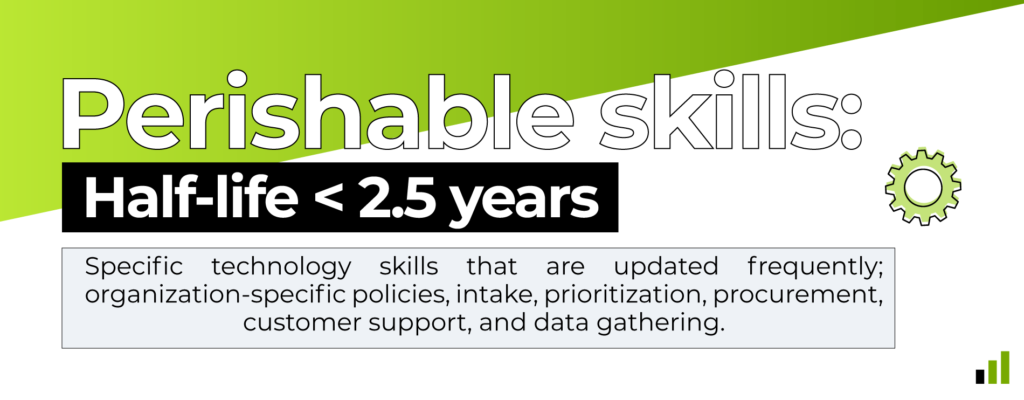
Skills are evolving at an unprecedented pace, and it’s important to have both types of skills in your toolbox. Workers need to consider if their skills are durable or perishable, and whether they can be transferred across different job families and industries.
Perishable skills include learning the latest version of a platform or being knowledgeable about a certain topic. While these skills must be taught and can be valuable, they can also quickly become outdated. These processes are dependent on fluid tools, organizational structures, software, and team dynamics, all of which are subject to rapid change.

In between perishable and durable we can also categorize skills as semi-durable, they’re longer-lasting and more valuable than the perishable skills but are still likely to be replaced as the field expands. This includes various learning theories that are in play today but will advance as businesses pivot their strategy and approach. Professionals with these skills can likely find work, even if their companies pivot their business strategy. However, they can also use these skills to pivot with their companies and find new ways to apply them.
Durable skills are rarely taught professional capabilities. They have a base layer of mindsets and dispositions. While these skills are more challenging to define and measure, they’re indispensable. According to America Succeeds, seven out of the ten most requested skills in job postings are durable skills. Employers should approach training by focusing on these skills first to make longer-term, profitable contributions.
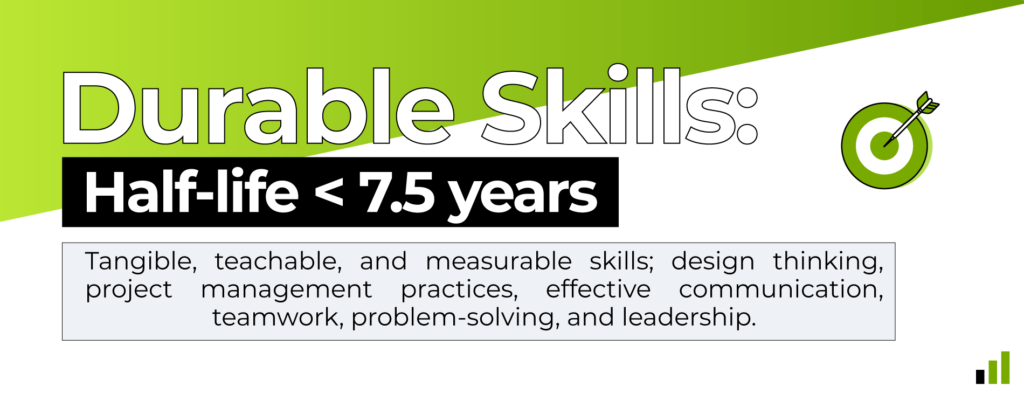
The COVID-19 pandemic has led to unprecedented changes in the workplace. Now moving towards a post-pandemic world, workers need to be more strategic than ever before about the skills they possess and how long those skills will remain relevant. To navigate this new landscape successfully, workplaces need to assess and invest in employees’ capabilities.
Technology Insights
In section 1, we outline the technologies on our platform that were the most popular, fastest-growing, and saw the biggest growth. We also break down the most popular IT skills, resources, frameworks, and libraries of some of the most popular tech stacks on the DevSkiller platform.
This section helps developers and recruiters understand how popular certain frameworks, libraries and languages are on the DevSkiller platform. This information will help you decide what technologies are the most useful to assess in the coming year.
JavaScript (23%) takes over Java (19%) as the most popular technology on the DevSkiller platform
JavaScript is the most in-demand technology for 2023. JavaScript (23%) overtook last year’s winner Java (19%) with a 5 percentage point increase. This finding is echoed in the 2022 Stack Overflow Developer Survey where JavaScript was the most commonly used programming language from the 70,000 surveyed respondents.
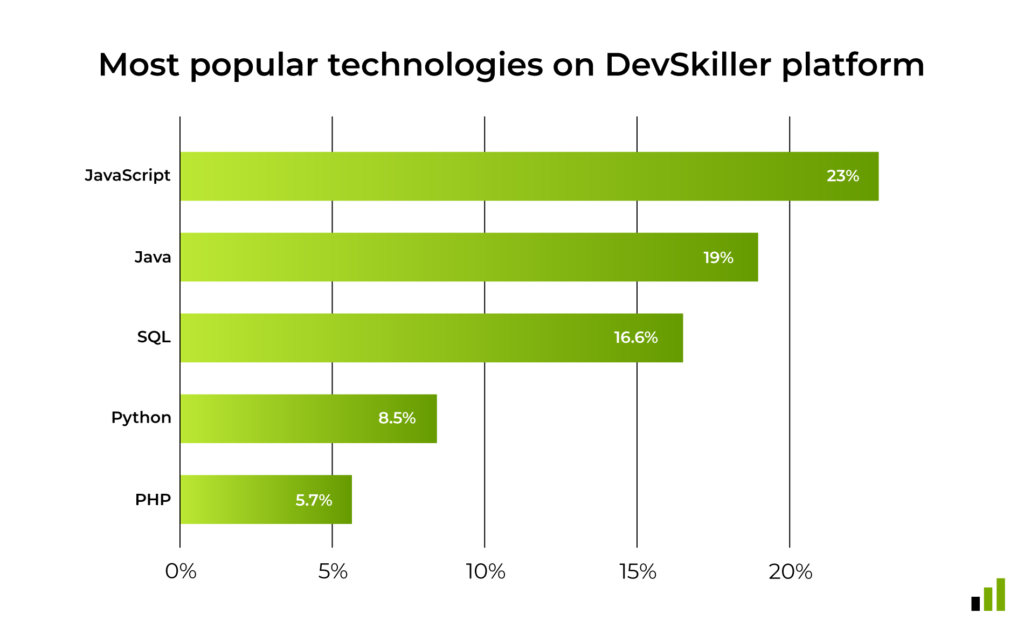
Rounding out the top five most popular technologies are SQL (16.60%), Python (8.50%), and PHP (5.70%). Java results stayed the same as last year’s data, while SQL dropped from 19%. This is the third year running that Python has placed in the top 5 most popular technologies on our platform, and this should come as no surprise given Python’s current position on the TIOBE index.
Data Science (5.60%) narrowly missed out on the top honors, coming in as the 6th most popular technology in this year’s report. It is very likely that we will see Data Science crack into the top 5 next year given the continued investment into data research and analysis from companies all over the world.
Blockchain sees 552% growth
In section 1.1 we note that JavaScript was the most popular technology on the DevSkiller platform, however, Blockchain was the fastest-growing technology on the DevSkiller platform. Interest in blockchain is on the rise likely because of its enhanced security, greater transparency, and instant traceability. Companies are changing or adding blockchain to their pre-existing architecture so the demand for developers who can implement this technology is on the rise.
Rounding out the top five fastest-growing technologies are Kotlin (205%), Cybersecurity (176%), Salesforce (128%), and Go (94%).
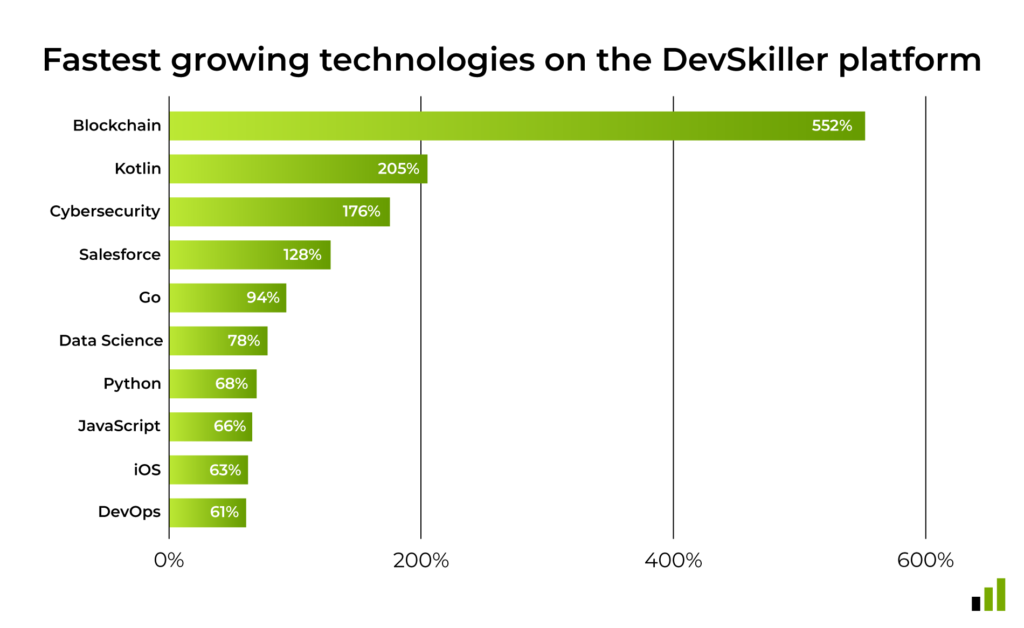
We had more requests from new customers in the past year than ever before for Blockchain and low-code and no-code technologies, such as Salesforce – which had an individual growth of 128%.
Mobile technology has not slowed down either. Kotlin was the second fastest-growing technology, a huge leap compared to the previous year when it didn’t make the top five list. Kotlin is likely becoming more popular because of its multi-platform capabilities and the continued investment in mobile technologies. Similarly, iOS came in ninth on the list with 63% individual growth.
DevSkiller is one of the only skills assessment providers that provide skills assessment for technologies like Blockchain and Salesforce.
JavaScript (47.07%) had the outright largest growth year over year
In section 1.2, we explored the year-over-year growth of the technologies we support on our platform. In section 1.3, we take a look at the individual technologies that contributed the most to overall platform growth. To no surprise, JavaScript led the way with a whopping 47.07%. According to Stack Overflow’s 2022 Developer Survey, JavaScript has come in first for the most popular technology for the tenth year in a row.

Python (17.70%) had the second highest growth contribution because it too is a widely-used technology for companies across all industries. Java is more popular in large, stable companies which are hiring fewer than in smaller companies. Python is chosen by programmers because of its easy-to-read code and it encourages program modularity and code reusability. Businesses choose to create with Python likely because it reduces the job time developers spend coding.
Data Science (12.57%), Java (5.16%), and DevOps (4.65%) round out the top five spots for individual technologies that contributed to the biggest growth across our platform.
Java 11, .NET framework, SQL, Python 3.x, PHP 8, HTML, Machine Learning, Linux, Solidity, and Ruby are the most popular skills in their respective tech stacks.
At DevSkiller, we take immense pride in the fact that our skills assessments provide a 360° view of a developer’s coding ability. We provide these insights by assessing a developer’s understanding of the entire tech stack they will be working on, not just their knowledge of a given programming language.
In this section, we’ve highlighted the most popular IT skills, resources, frameworks, and libraries of some of the most popular tech stacks on the market. In this year’s report, we’ve extended those insights to 11 in total by adding data on both Blockchain and Ruby.
The most popular tech stacks we test
| 1. React | 26.88% |
| 2. Node.js | 24.69% |
| 3. TypeScript | 20.63% |
| 4. Angular | 17.19% |
| 5. ES6 | 10.63% |
| 1. Java 11 | 35.46% |
| 2. Spring | 30.42% |
| 3. Spring Boot | 17.28% |
| 4. Maven | 8.67% |
| 5. JPA | 8.16% |
| 1. .NET Framework | 28.67% |
| 2. ASP.NET | 23.33% |
| 3. .NET Core | 19.50% |
| 4. ASP.NET MVC | 14.67% |
| 5. .NET 5 | 13.83% |
| 1. MySQL | 51.49% |
| 2. MSSQL | 14.34% |
| 3. PostgreSQL | 14.22% |
| 4. MongoDB | 14.10% |
| 5. NoSQL | 5.85% |
| 1. Python 3.x | 52.71% |
| 2. MongoDB | 17.95% |
| 3. Django | 11.59% |
| 4. Data Analysis with Python | 8.87% |
| 5. PySpark | 8.87% |
| 1. PHP 8 | 32.90% |
| 2. PHP 7 | 31.61% |
| 3. Laravel | 15.48% |
| 4. Doctrine | 11.29% |
| 5. WordPress | 8.71% |
| 1. HTML | 56.90% |
| 2. CSS | 32.76% |
| 3. WCAG 2.0 | 5.96% |
| 4. Sass | 2.51% |
| 5. LESS | 1.88% |
| 1. Machine Learning | 30.14% |
| 2. Data analysis | 27.40% |
| 3. Pandas | 26.48% |
| 4. Spark | 8.68% |
| 5. Big Data | 7.31% |
| 1. Linux | 26.31% |
| 2. Docker | 25.00% |
| 3. Terraform | 18.75% |
| 4. AWS | 17.30% |
| 5. Bash | 12.65% |
| 1. Solidity | 43.71% |
| 2. Hardhat | 21.85% |
| 3. Smart Contracts | 15.23% |
| 4. Truffle | 11.26% |
| 5. Chainlink | 7.95% |
| 1. Ruby | 41.93% |
| 2. Ruby on Rails | 29.81% |
| 3. Rake | 27.64% |
| 4. Ruby Core | 0.62% |
React (26.88%) tops the JavaScript tech stack for the 4th year running
React leads the way yet again as the most popular technology within the JavaScript tech stack. Node.js (24.69%) came in a close second this year which should be no surprise given it topped the most popular web frameworks and technologies in The 2022 Stack Overflow Developer Survey. Rounding out the top 5 were TypeScript (20.63%), Angular (17.19%), and ES6 (10.63%).
Java 11 (35.46%) gets top honors in the Java tech stack
In this year’s report, we decided to include Java 11 in our findings. While we provide support for other Java versions (including Java 8 and Java 17), it was Java 11 (35.46% that led the way in this year’s report. Spring (30.42%) came in a close second while Spring Boot (17.28%) came in third. Rounding out the top 5 this year were Maven (8.67%) and JPA (8.16%).
MySQL (51.49%) is the most popular Database Technology on the DevSkiller platform
MySQL (51.49%) led all Database Technologies, seen in over half of all Database skills assessments. This finding was echoed in the 2022 Stack Overflow Developer Survey where it also gained the top spot. HSQLDB (14.34%), MSSQL (14.22%), and Postgre (14.10%) could have easily exchanged places while placing in second, third, and fourth positions respectively. NoSQL (5.85%) rounded out the top 5.
HTML (56.90%) beats out CSS (32.76%) as the most popular Web Development skill
This year we decided to analyze HTML and CSS individually to determine which was the more popular technology within Web Development related tasks. Interestingly HTML (59.90%) beat out CSS (32.76%) by some margin in our findings, seen in 27.14% more skills assessments. WCAG 2.0 (5.96%), Sass (2.51%), and Less (1.88%) rounded out the other remaining positions.
Python 3.x (52.71%) retained the top spot in the Python tech stack
Python 3.x (52.71%) was seen in more than half of Python-related skills assessments in the past 12 months. This is slightly lower than last year when it was seen in 59.7% of Python assessments. MongoDB (17.95%), Django (11.59%), Data Analysis with Python (8.87%), and PySpark (8.87%) rounded out the remainder of the top 5.
Machine Learning was seen in 30.14% of Data Science skills assessments
Machine Learning (30.14%) has overtaken Data Analysis (27.40%) as the most popular in Data Science skills assessments. Last year, Data Analysis (24.04%) took out the top spot with 27.40% however the increased prevalence of Machine Learning testing meant it could not hang onto its position. Pandas (26.48%), Spark (8.68%), and Big Data (7.31%) occupied the remaining slots.
.NET Framework (28.67%) leads the way in the .NET/C# skills assessments
.NET Framework (28.67%) has gained the top spot this year after placing second in last year’s report. The flexibility that the .NET Framework provides for software applications is likely the cause of its increased popularity this year. ASP.NET (23.33%) dropped one place this year finishing second while .NET Core (19.50%) came in third. Rounding out the top 5 for .NET/C# skills assessments in 2022 were ASP.NET MVC (14.67%) and .NET 5 (13.83%).
PHP 8 (32.90%) is the most popular technology in PHP skills assessments
PHP 8 (32.90%) narrowly beat last year’s winner PHP 7 (31.61%) by just over 1%. The newer version of PHP boasts better performance than its predecessor which is a likely contributor to its position in this year’s report. Laravel (15.48%), Doctrine (11.29%), and WordPress (8.71%) rounded out the top 5.
Linux retains top position seen in 26.31% of DevOps skills assessments
This is the second year we’ve included data on the DevOps tech stack and for the second year in a row, Linux (26.31%) came in first position. Docker came in a close second with 25% while Terraform (18.75%), which didn’t even finish in the top 5 last year, came in third. AWS (17.30%) and Bash (12.65%) rounded out the top 5.
Solidity (43.71%) is the most popular Blockchain technology
Over the last year, Blockchain was one of the most requested technologies from our customers and prospective customers. As a result, we decided to include data from Blockchain in this year’s report. Solidity (43.71%) came in the first position by some distance, beating out Hardhat (21.85%) which came in second. Smart Contracts (15.23%), Truffle (11.26%), and Chainlink (7.95%) came in third, fourth, and fifth positions respectively.
Ruby was seen in 41.93% of all Ruby on Rails skills assessments
This year, we also decided to include data on our Ruby/Rails skills assessments for the first time. Ruby (41.93%) beat out Ruby on Rails (29.81%) to occupy the first 2 positions in this category. Rake (27.64%) and Ruby Core (0.62%) occupied the remaining slots.
Tech Candidate Behavioral Insights
In section 2, we break down tech candidate behavioral data. We outline their test completion rate, the average time to take the test, the most popular day of the week to take the tests, and the most tested candidates by country.
We observed a wide range of test-taking behavior insights across different countries. This data provides us with valuable insight into how candidates engage with our platform across the world. By leveraging this data, we can continue to optimize our platform to ensure the best possible experience for talent and organizations.
92.68% of DevSkiller skills assessments are completed
At DevSkiller, we place candidates at the center of our efforts by providing skills assessments that are not only enjoyable but accurately represent a candidate’s skills. As a result, 92.68% of DevSkiller skills assessments were completed over the past 12 months.
Candidates take on average 2 days and 3 hours to submit a DevSkiller skills assessment
The average wait time between a candidate receiving a skills assessment invitation and taking it was 2 days and 3 hours. This finding represents an improvement in wait time compared to last year’s report (2 days and 16 hours). The change in time was likely caused by candidates being more eager to find a new position due to uncertainty in the job market.
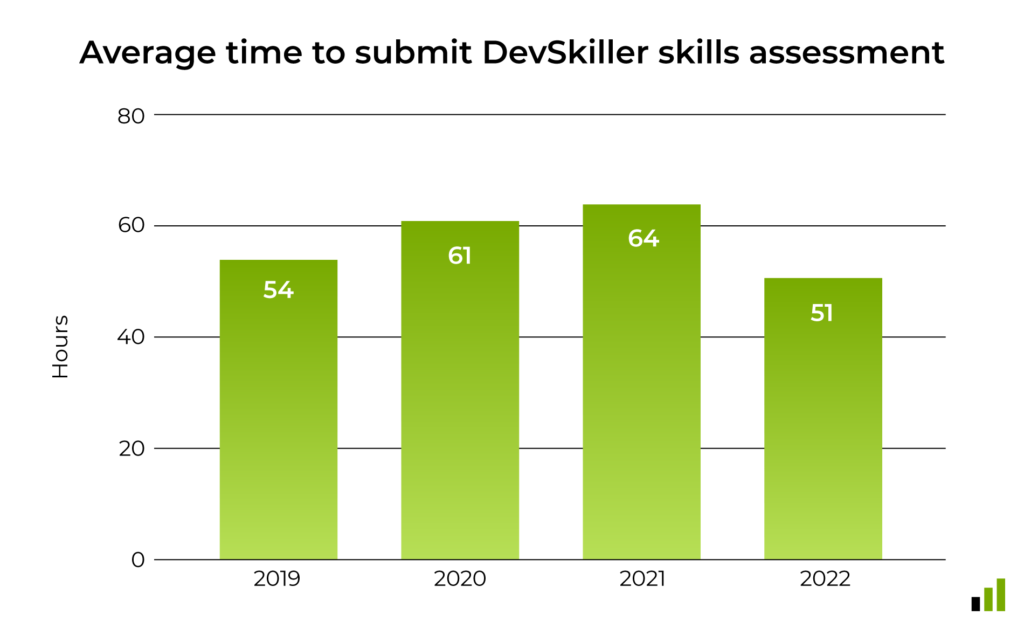
Another cause could be related to an increased amount of internal testing. Over the past 12 months, we’ve seen more internal testing from our customers—where they send assessments to current employees as opposed to external candidates. Internal assessments tend to be completed at a faster rate than with external candidates.
Skills assessments sent on a Wednesday get the fastest response time for the fourth consecutive year
DevSkiller skills assessments that were sent on a Wednesday have received the fastest response time. Assessments sent at the beginning of the workweek are likely to be finished at a faster rate. Unsurprisingly, the response times for assessments sent between Friday and Sunday were much longer than those sent during weekdays.
German developers are the most commonly tested on the DevSkiller platform
Global hiring was a continuing trend among our customers in the last year. As the popularity of hybrid and remote work has continued to grow, companies have become more flexible in where they source and hire employees. Now more than ever candidates care about balance and flexibility in their work lives.
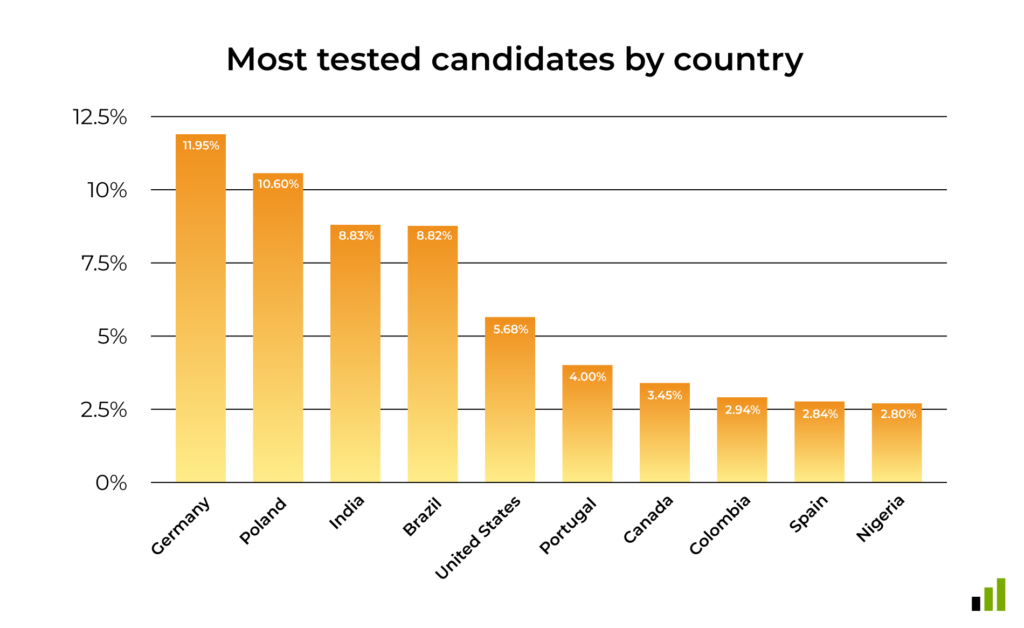
Developers from Germany (11.95%) were the most tested candidates in 2022, while Poland was a close second with 10.60%. Developers from India, Brazil, and the United States round out the top five of the largest pools of talent in 2022.
Skills Management Insights
In section 3, we take a look at the number of skills required for a variety of in-demand technical roles. The data is broken down into three levels of seniority; junior, middle, and senior level.
The data was collected from TalentBoost, our skills management platform. TalentBoost has over 500 skills groups that include 3000+ pre-defined skills for a variety of technical and digital roles. These skills insights help uncover and close digital skills gaps and build personalized career paths for their employees.
Junior technical positions require 40 skills on average
Junior technical roles usually require anywhere between 1 and 3 years of experience. The skills acquired at this stage of a developer’s career are usually at the fundamental level and are further developed while other skills are added to this base with more experience. For this reason, the amount of skills acquired at the junior level is considerably lower for middle and senior roles. In fact, the amount of required skills is less than half of that required to effectively fill a mid-level technical position.
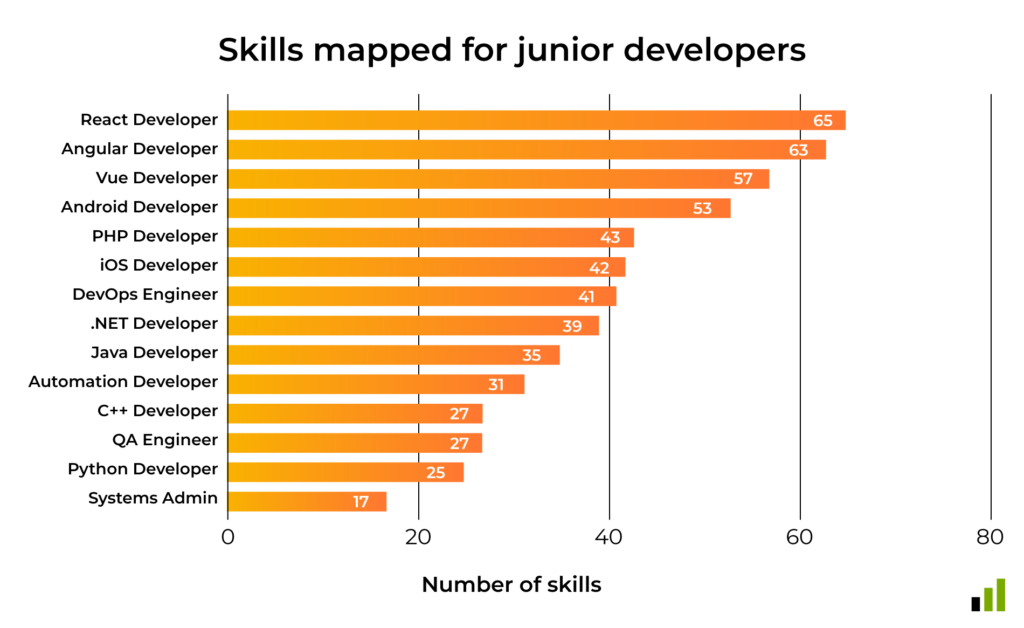
Junior React developers require the largest amount of skills at 40, while Systems Administrators only require 17 skills for junior roles.
The average number of skills for mid-level developers is 106 skills
Mid-level technical positions comprise 106 skills on average. Mid-level developers are those with between 3 and 6 years of experience. React developers again led the way with 158 skills in total for mid-level positions. Angular (150), Vue (142), Android (140), and PHP (134) rounded out the top 5.
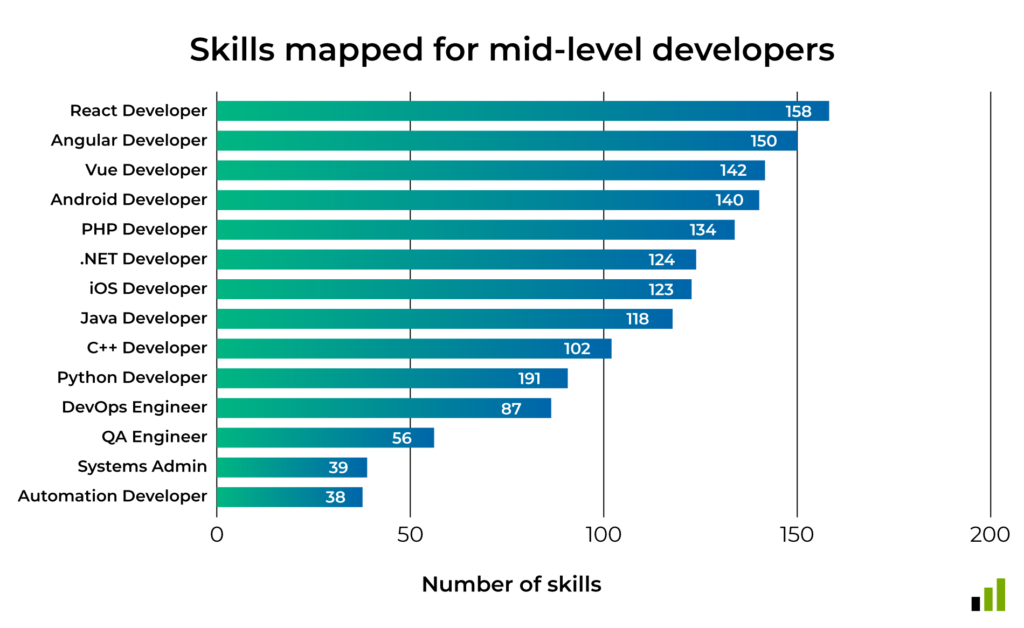
It is important to note, that while there are many skills available, no single developer will necessarily know each and every skill with the same level of proficiency. Required skills are predetermined by the tech stack that a given company uses. For example, a Java developer at company X may primarily use Gradle while a Java developer at company Y uses Maven more frequently. By the same token, a JavaScript developer could use Angular in their daily work while another JavaScript developer is more proficient in React.
Senior developers require 150 skills on average
In the past 12 months, our customers mapped 150 skills for senior developers on average. Angular (243), Vue (237), iOS ( 199), Android (195), and Java (182) took out the top 5 positions in this year’s report. These findings represent the total number of skills mapped for senior level technical positions. A single Angular (243) or .NET (171) developer would not possess every skill that was mapped, but rather only those specific to his or her company’s tech stack.
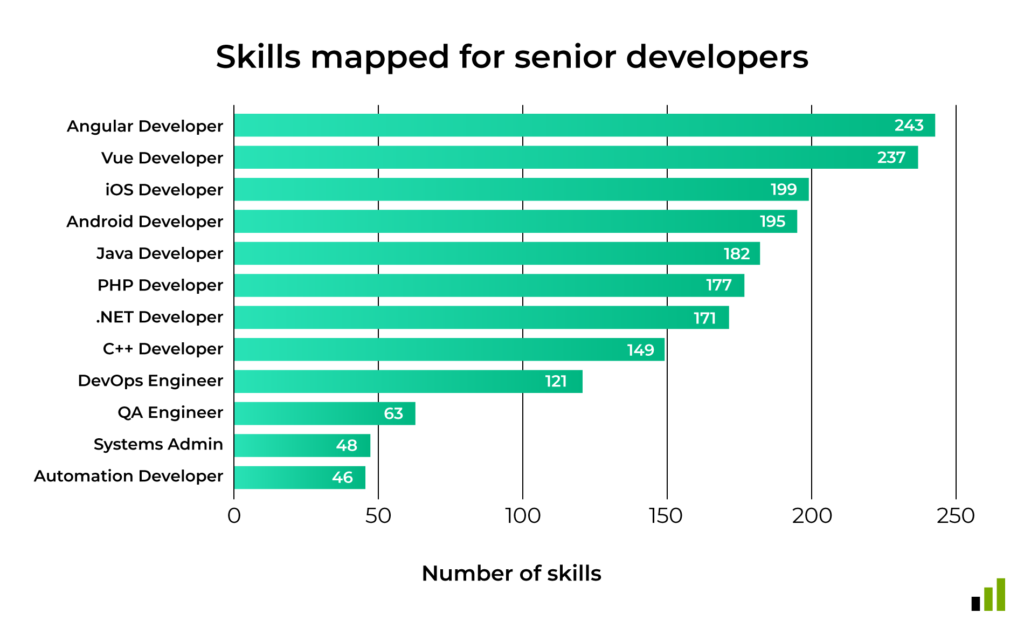
Another important takeaway from this section is the omission of certain technologies such as React and PHP. Oftentimes, technical senior roles do not require additional skills, but instead, greater skill proficiency. For instance, a mid-level React developer may only require 40% proficiency level in React Virtual Dom vs 70% proficiency at the senior level.
Developer Seniority Insights
DevSkiller skills assessments provide an excellent opportunity to evaluate developers of varying levels of seniority. In section 4, we analyze how junior, middle, and senior developers performed on our platform. Then, we break down the highest scorers at each level by country.
These insights can help you better understand the capabilities of different types of developers and make more informed decisions when hiring or evaluating your team. By understanding the differences in seniority levels, you can ensure that you have the right people in the right roles.
50.74% of our customers were testing for junior developers in 2022
One of the major advantages of DevSkiller skills assessments is the ability to evaluate programmers of varying levels of seniority. We have a library of over 5000 recruitment tasks for developers of all levels of seniority.
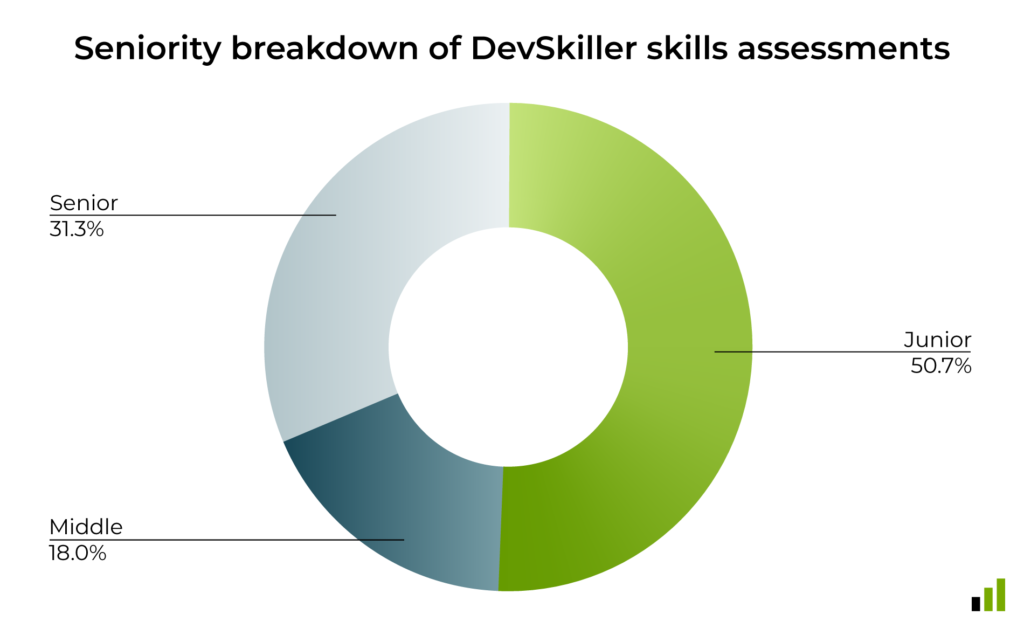
In 2022, 50.74% of skills assessment invitations were for junior developers, 17.98% were for middle developers, and 31.28% for senior developers and engineers. Our RealLifeTesting™ methodology immerses candidates in real work instead of forcing them to solve algorithmic puzzles, which is indispensable when it comes to assessing technical talent.
Junior developers from the Dominican Republic and Greece (91%) scored highest on DevSkiller Skills Assessments
The Dominican Republic and Greece tie for the number one spot of highest-scoring junior developers with a 91% assessment score. The United Kingdom, Indonesia, and Romania trail close behind with 88% and 89% respectively. Overall, junior developers scored higher than mid-developers.
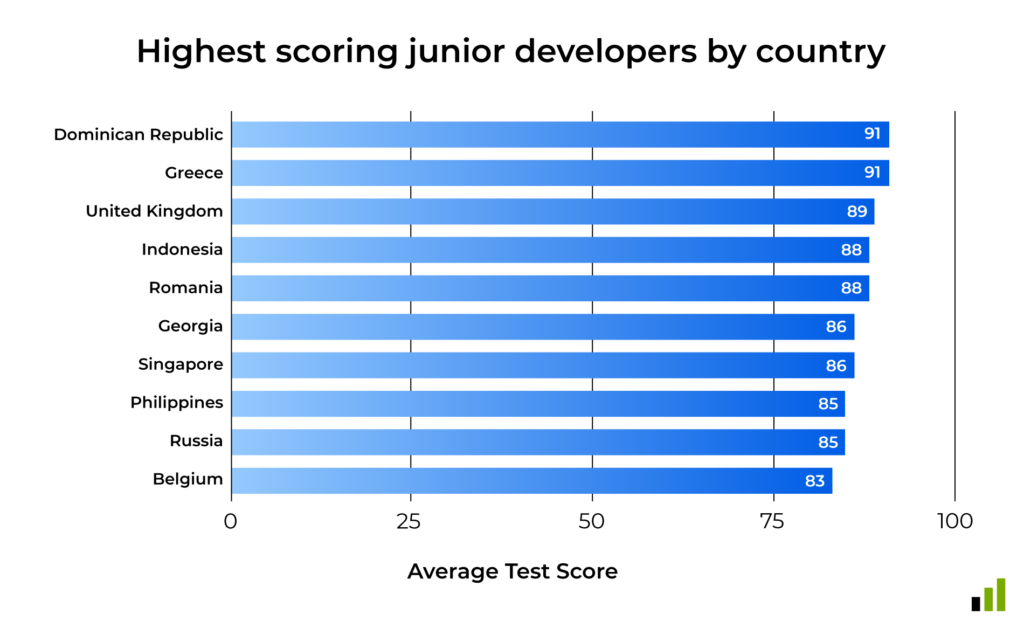
In 2022, 50.74% of skills assessment invitations were for junior developers and engineers, a 10 percentage point increase from the previous year’s report. There was likely an increase in the number of juniors assessed due to the high demand for developers and engineers. Companies are likely more open to candidates who’ve reskilled themselves from different roles regardless of their educational background.
Mid-level developers from South Africa (87%) scored highest in the past year
South African middle developers scored the highest on assessments with 87%. The Dominican Republic (82%) and Romania (81%) Greece (79%), and Russia (79%) round out the top five spots for highest-scoring middle developers. There was only 8% percentage points separating the top 5 countries for mid-level developer candidates.
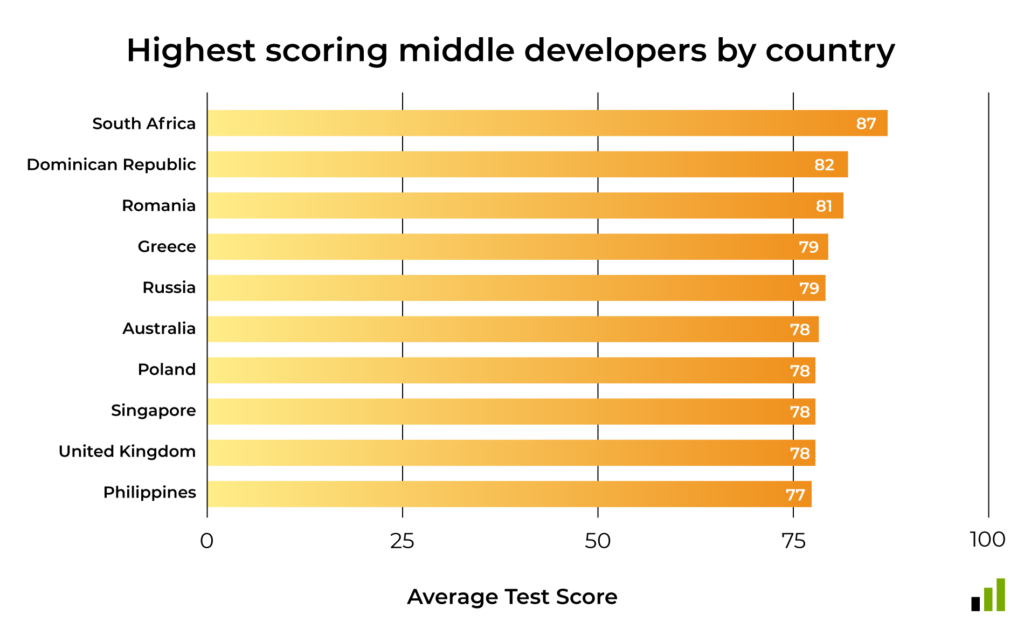
Senior developers from Indonesia (94%) scored highest on DevSkiller skills assessments
Senior developers in Indonesia (94%) scored 9 percentage points higher than the second-highest country, Argentina (83%). Rounding out the top five countries are Greece (81%), Israel (81%), and the United States (80%) scoring on average 13-14 percentage points lower than Indonesia.
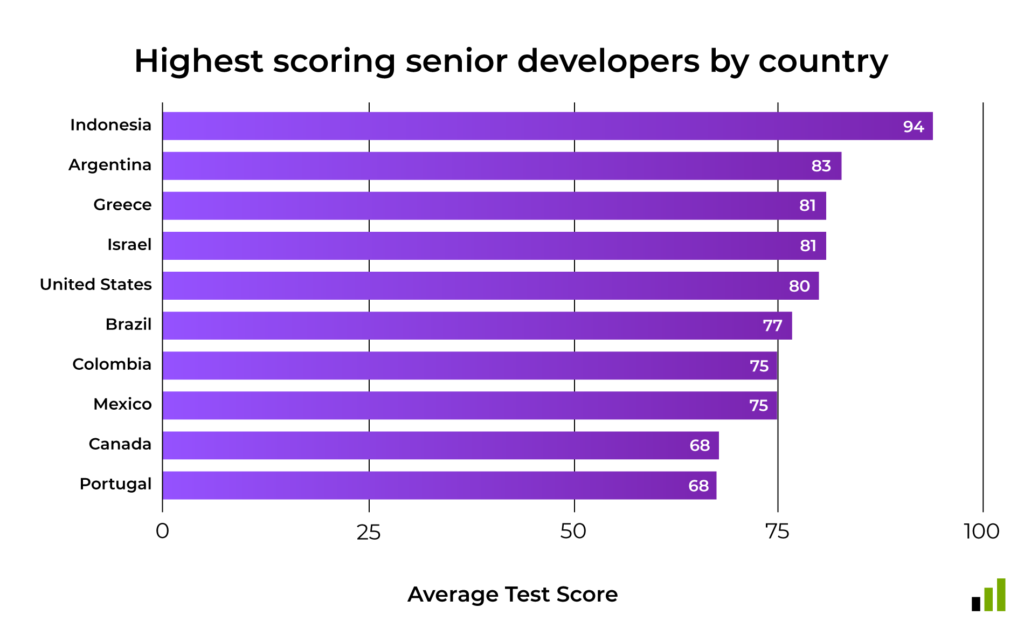
Customer Insights
In section 5, we break down the customer data insights. From the average number of test invitations sent by customers to the most candidates tested by the company, and the most popular task types on the platform.
These insights can provide you with the information you need to better understand how your organization can adopt our skills assessment and skills management software.
DevSkiller customers sent 473 skills assessments on average over the past year
On average, our customers sent out 473 skills assessments over the past year. This number represents a 27.49% increase from the previous year’s report. In 2021, the average number of skills assessments sent was 371. Since 2018 the number of assessments sent has increased continually year over year.
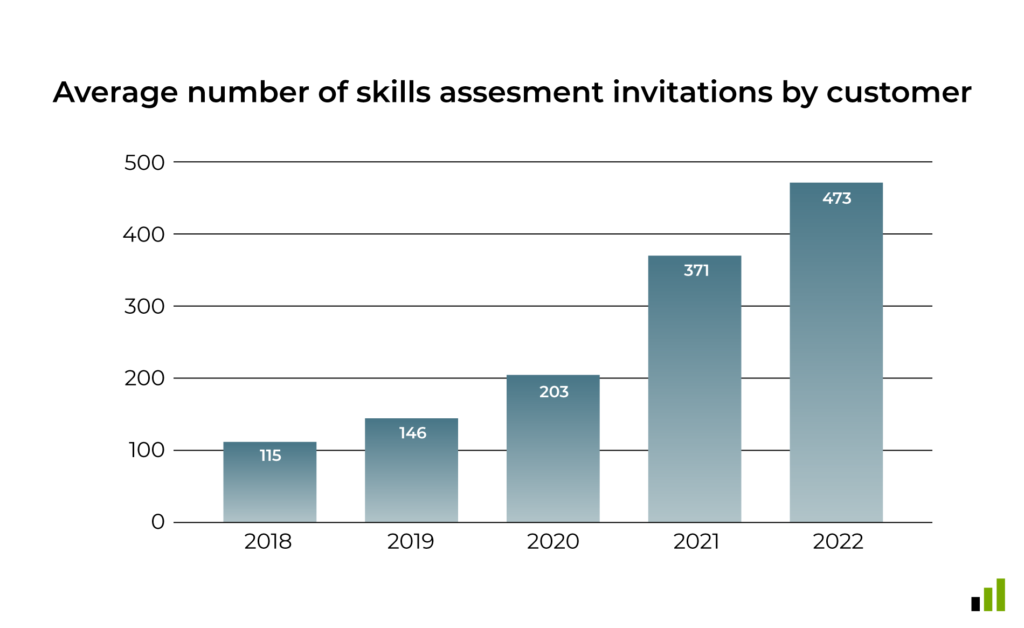
Brazilian companies tested the most developers with DevSkiller in 2022
Brazilian companies accounted for 20.76% of skills assessments sent on our platform over the past year. Companies from The United States were the second most active country, accounting for 16.75% of assessments sent on the DevSkiller platform. Poland was right behind the US with 16.70%. The top three countries account for almost 50% of all companies testing on the DevSkiller platform.
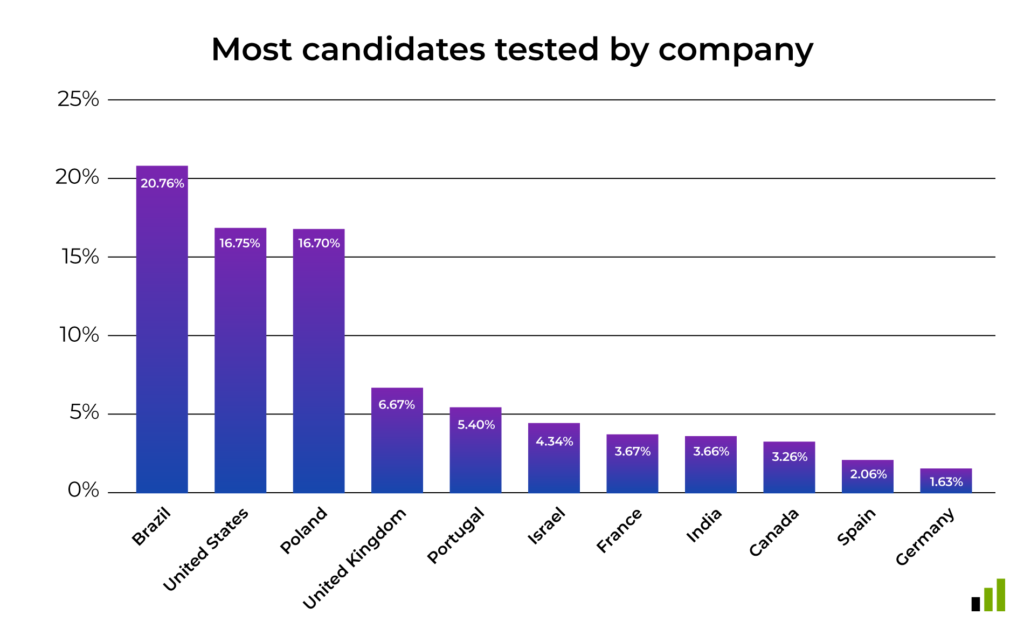
Companies from the United Kingdom (6.67%) and Portugal (5.40%) have rounded out the top five spots over the past year.
Code gaps were the most popular task type on the DevSkiller platform
Code gaps (70.67%) were the most popular task type used for vetting technical skills, both internally and externally. Code gap questions assess whether or not the candidate has an understanding of object-oriented programming in general. Programming (22.42%) is the second most popular task type used, this is likely a lower percentage because code gap questions are initially used to test someone’s problem-solving skills. The third most popular task type assessed is SQL (5.84%).
Note – DevOps and Testing are part of paid extensions, thus they have less testing platform-wide.
Outlook, Predictions, and Recommendations for 2023
Global Recession
With the increase in automation and sky-high inflation in 2022, several financial institutions predict a global recession by the middle of 2023. Two-thirds of our surveyed customers stated that they believe a global recession is most likely to occur in 2023. Now is the time to prepare for a worldwide recession before it is too late.
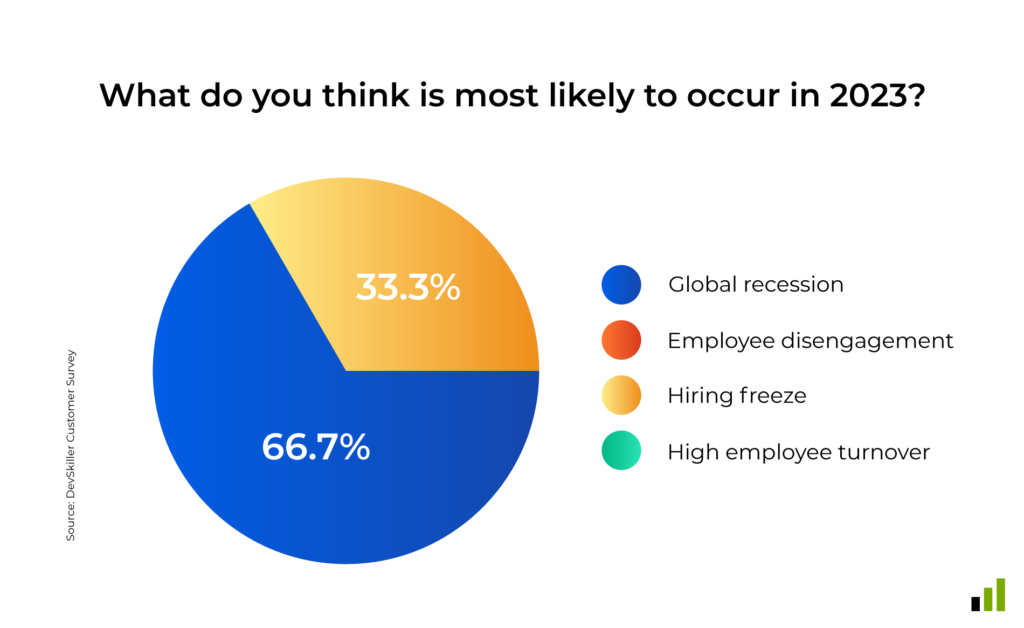
As a candidate, you can start by upskilling and reskilling yourself in different areas to make yourself more dynamic to potential employers. Update your LinkedIn profile and start being more active within your field’s community. You can begin by updating your CV, reaching out to your network, and continuing to upskill and reskill yourself.
Hiring Freeze
While some big market players like Meta, Amazon, Twitter, Stripe, and Microsoft, have taken a huge hit, laying off thousands of employees, others have imposed hiring freezes for the foreseeable future. According to Layoffs Tracker, more than 245,000 people were laid off globally in 2022, with the most significant jump in layoffs in November.
One-third of our surveyed customers stated that they believe a hiring freeze is most likely to occur in 2023. “Deep-seated and long-term supply dynamics will continue to be a major force that creates a persistent gap between employer demand for new hires and the supply of candidates,” according to Indeed and Glassdoor’s Workplace Trends 2023.

The best way your organization can prepare for potential hiring freezes is to look in-house for internal candidates. It’s time to assess and map out individuals’ skills. Once you have a clearer understanding, create training and programs to upskill and reskill your employees. You can use the skills-based approach to shift your employees’ focus onto projects instead of their job roles.
Sudden Talent Pool
At the start of the pandemic, many companies had to shift their presence online creating a need for developers and engineers who could handle the task of creating websites, e-commerce, and other workflows. Now after nearly three years, we’re seeing a shift in the opposite direction. Tech talent is flooding the market after the major market player layoffs. This trend could offer more stable, traditional companies an opportunity to snatch up the talent and move to modernization.
However, the talent scarcity crisis is far from over. According to the Dice Tech Job Report, in the US there are 85,000 workers in the tech sector looking for employment; more than 375,000 tech jobs remain unfilled. The problem comes down to the persistent skills shortage.
As an organization, focus on strengthening your team. It’s time to reaffirm your company’s core values and mission to your employees. Supporting your employees through difficult times will result in loyalty and a determination to push the business forward. Now is the time to pursue talent with DevOps, automation, Cloud, and cybersecurity skills to help your company develop new technologies and optimize workflows.
Methodology
The data we used for this study came from a 365-day snapshot of users on our platform between December 1st, 2021 and December 1st, 2022. The report’s findings are based on 209,249 coding tests sent through the DevSkiller platform to candidates from 54 countries. All data presented here is generic aggregated demographic information. It is not linked to any specific information regarding certain candidates or companies.
If you have any questions or comments regarding the report, you can get in touch with us by emailing research@devskiller.com.
